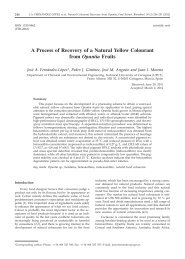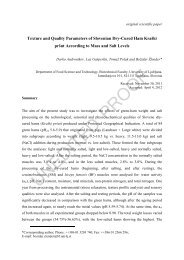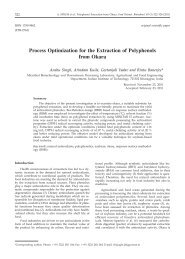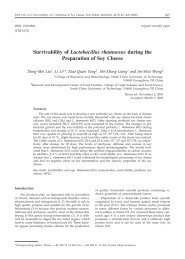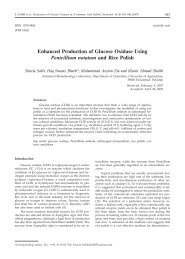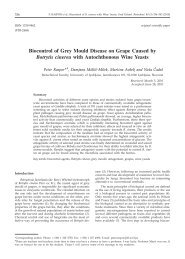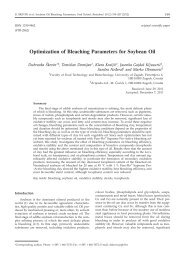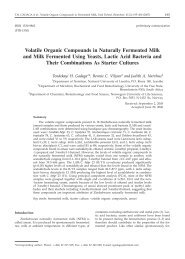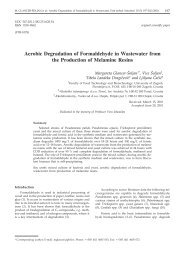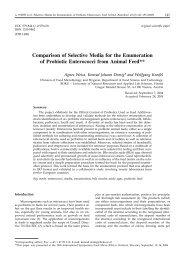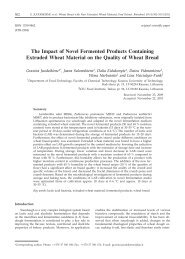Extraction and Purification of Glucoamylase and Protease Produced ...
Extraction and Purification of Glucoamylase and Protease Produced ...
Extraction and Purification of Glucoamylase and Protease Produced ...
You also want an ePaper? Increase the reach of your titles
YUMPU automatically turns print PDFs into web optimized ePapers that Google loves.
310 S. NEGI et al.: Single-Stage Fermentation <strong>of</strong> <strong>Glucoamylase</strong> <strong>and</strong> <strong>Protease</strong> by A. awamori, Food Technol. Biotechnol. 49 (3) 310–315 (2011)<br />
ISSN 1330-9862 original scientific paper<br />
(FTB-2762)<br />
<strong>Extraction</strong> <strong>and</strong> <strong>Purification</strong> <strong>of</strong> <strong>Glucoamylase</strong> <strong>and</strong> <strong>Protease</strong><br />
<strong>Produced</strong> by Aspergillus awamori in a Single-Stage<br />
Fermentation<br />
Sangeeta Negi 1 *, Suneel Gupta 1 <strong>and</strong> Rintu Banerjee 2<br />
1 Biotechnology Section, Applied Mechanics Department, Motilal Nehru National Institute <strong>of</strong> Technology,<br />
Teliyarganj, Allahabad, 221004 Uttar Pradesh, India<br />
2 Agriculture <strong>and</strong> Food Engineering Department, Microbial Biotechnology <strong>and</strong> Downstream Processing<br />
Laboratory, Indian Institute <strong>of</strong> Technology, Kharagpur, 721302 West Bengal, India<br />
Introduction<br />
Received: November 20, 2010<br />
Accepted: February 24, 2011<br />
Summary<br />
Simultaneous extraction <strong>and</strong> purification <strong>of</strong> glucoamylase <strong>and</strong> protease produced concomitantly<br />
by Aspergillus awamori Nakazawa MTCC 6652 in a single fermentor using solid-<br />
-state fermentation (SSF) has been studied. Soaking for 2hatroomtemperature (around<br />
30 °C) in 10 % glycerol was found to be most suitable for optimum simultaneous extraction<br />
<strong>of</strong> glucoamylase <strong>and</strong> protease with the yield <strong>of</strong> 8645.8 U/g <strong>of</strong> glucoamylase <strong>and</strong> 798.6<br />
U/g <strong>of</strong> protease in dry substrate. Crude extract to acetone ratio <strong>of</strong> 1:2 yielded optimum simultaneous<br />
precipitation <strong>of</strong> glucoamylase (35.3 %) <strong>and</strong> protease (61.9 %) with 4.06- <strong>and</strong><br />
7.17-fold purification, respectively. Ion exchange chromatography showed specific activities<br />
<strong>of</strong> purified fractions <strong>of</strong> 253.2 U/mg <strong>of</strong> glucoamylase <strong>and</strong> 59.7 U/mg <strong>of</strong> protease, with<br />
22.1 <strong>and</strong> 40.8 % recovery, respectively. After gel filtration chromatography specific activity,<br />
recovery <strong>and</strong> purification <strong>of</strong> glucoamylase were found to be 306.8 U/mg, 4.6 % <strong>and</strong><br />
6.25-fold, respectively, whereas those <strong>of</strong> protease were 85.6 U/mg, 12.9 % <strong>and</strong> 17.0-fold, respectively.<br />
SDS-PAGE <strong>and</strong> zymogram studies <strong>of</strong> the purified enzymes indicated the presence<br />
<strong>of</strong> three starch-hydrolyzing is<strong>of</strong>orms <strong>of</strong> glucoamylase with molecular mass <strong>of</strong> approx.<br />
109.6, 87.1, <strong>and</strong> 59.4 kDa <strong>and</strong> two types <strong>of</strong> acid protease with molecular mass <strong>of</strong><br />
approx. 47.9 <strong>and</strong> 35.5 kDa. These findings can be very useful for enzyme industry, where<br />
glucoamylases <strong>and</strong> proteases are used concurrently.<br />
Key words: extraction, purification, amylase, protease, Aspergillus awamori<br />
The necessity <strong>of</strong> cost-effective production <strong>and</strong> simultaneous<br />
applications <strong>of</strong> more than one enzyme in enzymatic<br />
processes have given thrust to the production <strong>of</strong><br />
multiple enzymes from a single fermentation. Amylases<br />
<strong>and</strong> proteases are among the most widely used industrial<br />
enzymes having various applications in industries<br />
like leather, brewing, textile, paper, distilling, food processing,<br />
pharmaceuticals, waste decomposition, detergent,<br />
etc. (1). Amylases <strong>and</strong> proteases are concurrently<br />
used in many industries such as soy sauce, bakery, detergent,<br />
vegetable oil, soy milk, cheese production, etc. <strong>Glucoamylase</strong>s<br />
<strong>and</strong> proteases produced concomitantly in a<br />
single-stage fermentation can be very useful for various<br />
applications such as detergent, bio-ethanol, animal feed<br />
production, etc. In view <strong>of</strong> the wide range <strong>of</strong> applicability<br />
<strong>of</strong> glucoamylases <strong>and</strong> proteases, they are considered<br />
as the objects <strong>of</strong> the present investigation.<br />
Efficient extraction <strong>and</strong> purification <strong>of</strong> enzymes is<br />
vital for their subsequent use <strong>and</strong> integration in indus-<br />
*Corresponding author; Phone: ++91 941 501 5811; Fax: ++91 532 227 1200; E-mail: sn5@mnnit.ac.in, sangy20012001@yahoo.com
S. NEGI et al.: Single-Stage Fermentation <strong>of</strong> <strong>Glucoamylase</strong> <strong>and</strong> <strong>Protease</strong> by A. awamori, Food Technol. Biotechnol. 49 (3) 310–315 (2011)<br />
trial processes. There are very few reports on the extraction<br />
<strong>and</strong> purification <strong>of</strong> glucoamylase <strong>and</strong> protease produced<br />
concomitantly in single-stage fermentation. In one<br />
such investigation <strong>of</strong> concurrent extraction <strong>and</strong> purification<br />
<strong>of</strong> multienzyme complex, Krishna <strong>and</strong> Ch<strong>and</strong>rasekaran<br />
(2) reported the extraction <strong>of</strong> 32 800 U <strong>of</strong> a-amylase,<br />
380 U <strong>of</strong> protease <strong>and</strong> 90 U <strong>of</strong> cellulase from B.<br />
subtilis (2). Yang <strong>and</strong> Wang (3) reported the production<br />
<strong>of</strong> protease <strong>and</strong> amylase from Streptomyces rimosus TM-55,<br />
both in submerged as well as in solid-state fermentation<br />
(SSF). Production <strong>of</strong> multienzymes consisting <strong>of</strong> alkaline<br />
amylase <strong>and</strong> cellulase by mixed alkalophilic culture <strong>and</strong><br />
their potential use in the saccharification <strong>of</strong> sweet potato<br />
have been studied by Zhang et al. (4). Optimization <strong>of</strong><br />
the production <strong>of</strong> amylase <strong>and</strong> protease using evolutionary<br />
operation (EVOP) has been reported by Negi <strong>and</strong><br />
Banerjee (5). Amylase <strong>and</strong> protease from Streptomyces<br />
species were purified by a combination <strong>of</strong> ion exchange<br />
chromatography <strong>and</strong> gel filtration, <strong>and</strong> characterized by<br />
Etok <strong>and</strong> Eka (6).<br />
In the present study, glucoamylase <strong>and</strong> protease are<br />
produced concomitantly in solid-state fermentation. Various<br />
factors affect simultaneous extraction <strong>and</strong> purification<br />
<strong>of</strong> both glucoamylase <strong>and</strong> protease. Therefore, the<br />
aim <strong>of</strong> this study is to optimize various factors that affect<br />
the extraction <strong>and</strong> purification <strong>of</strong> glucoamylase <strong>and</strong> protease<br />
produced concomitantly in SSF by A. awamori, in<br />
order to obtain the best possible yield <strong>and</strong> purification<br />
<strong>of</strong> both enzymes simultaneously.<br />
Materials <strong>and</strong> Methods<br />
Microorganism <strong>and</strong> strain maintenance<br />
A filamentous fungus Aspergillus awamori Nakazawa<br />
MTCC 6652, isolated from the soil at the Indian Institute<br />
<strong>of</strong> Technology, Kharagpur, India, was explored for the<br />
production <strong>of</strong> extracellular multienzymes protease <strong>and</strong><br />
glucoamylase. Aspergillus awamori Nakazawa was maintained<br />
on 2 % malt extract agar slants. The microorganismwasallowedtogrowintheseslantsat37°Cfor<br />
six days for complete sporulation. It was stored at 4 °C<br />
for preservation.<br />
Inoculum preparation<br />
For inoculum preparation, 25 mL <strong>of</strong> sterile distilled<br />
water were added to the slant grown on malt extract plate<br />
for six days at 37 °C <strong>and</strong> scraped with inoculating loop<br />
aseptically. This suspension having spore concentration<br />
<strong>of</strong> approx. 1.3·10 6 cells/mL was used as inoculum for subsequent<br />
fermentation.<br />
Fermentation process<br />
Fermentation was carried out in a 500-mL conical<br />
flask containing 10 g <strong>of</strong> wheat bran soaked with 10 mL<br />
<strong>of</strong> salt solution. The medium was mixed properly, autoclaved,<br />
<strong>and</strong> inoculated with optimum spore suspension<br />
aseptically. Conical flasks were kept in a humidity chamber<br />
where temperature <strong>and</strong> humidity were maintained<br />
during fermentation.<br />
<strong>Extraction</strong> process<br />
After the fermentation was completed, the fermented<br />
substrate was soaked with water <strong>and</strong> other solutions<br />
for extraction <strong>of</strong> the enzymes. Filtration was done through<br />
a cotton cloth <strong>and</strong> maximum amount <strong>of</strong> extract was collected.<br />
The extract was centrifuged at 9780×g to remove<br />
the spores <strong>and</strong> other insoluble particles. The supernatant<br />
was kept at 4 °C for the assay <strong>of</strong> the enzymes.<br />
Solid-state fermentation<br />
A mass <strong>of</strong> 10 g <strong>of</strong> wheat bran soaked in 60 mL <strong>of</strong><br />
Czapek-Dox (containing in g/L: NaNO3 2.5, KH2PO4 1.0,<br />
MgSO4·7H2O 0.5, KCl 0.5) was mixed, autoclaved, then<br />
inoculated with optimum number <strong>of</strong> spores <strong>and</strong> incubated<br />
for four days at 37 °C <strong>and</strong> 85 % humidity. Fermentation<br />
was conducted under various experimental conditions<br />
(5).<br />
<strong>Glucoamylase</strong> assay<br />
311<br />
<strong>Glucoamylase</strong> activity was measured following the<br />
Bernfeld method (7). One unit <strong>of</strong> enzyme activity was<br />
defined as the amount <strong>of</strong> enzyme that released one mmol<br />
<strong>of</strong> glucose as the reducing sugar in one minute under<br />
the assay conditions.<br />
<strong>Protease</strong> assay<br />
<strong>Protease</strong> activity was measured by caseinolytic method<br />
(8). One unit <strong>of</strong> enzyme was defined as the amount<br />
<strong>of</strong> enzyme that liberated peptide fragments equivalent<br />
to 1 mg <strong>of</strong> bovine serum albumin (BSA) under the assay<br />
conditions.<br />
<strong>Extraction</strong><br />
Optimal extraction conditions were achieved by optimizing<br />
different parameters such as solvent selection,<br />
volume fraction <strong>of</strong> the solvent, soaking time, temperature,<br />
etc. by varying one parameter at a time while keeping<br />
the others constant. Fermented substrate was soaked<br />
with one <strong>of</strong> the solvents, <strong>and</strong> then filtered using cheese<br />
cloth to collect the extract. The extract was then centrifuged<br />
at 10 000×g to remove the insolubles, <strong>and</strong> the supernatant<br />
was stored at 4 °C.<br />
Solvent selection<br />
Various solvents such as water, 0.1 M phosphate<br />
buffer (pH=6.5), 10 % aqueous mixture <strong>of</strong> glycerol, ethanol,<br />
salt solution, <strong>and</strong> acetone were used to determine<br />
their effect on the extraction <strong>of</strong> glucoamylase <strong>and</strong> protease.<br />
During experiments, glycerol was found as the most<br />
suitable solvent for optimum simultaneous extraction <strong>of</strong><br />
glucoamylase <strong>and</strong> protease, hence, different volume fractions<br />
<strong>of</strong> glycerol were tested further to determine the best<br />
fraction for optimum extraction efficiency.<br />
Optimization <strong>of</strong> soaking time <strong>and</strong> temperature<br />
Optimum soaking time was determined by incubating<br />
the fermented biomass for the time period ranging<br />
from 30 min to 3 h, keeping other parameters at optimum<br />
level. Similarly, the best temperature for optimum<br />
extraction <strong>of</strong> both enzymes simultaneously was ascertained<br />
by conducting the experiments at 15, 30, 40 <strong>and</strong><br />
50 °C while keeping the other parameters at optimum<br />
level.
312 S. NEGI et al.: Single-Stage Fermentation <strong>of</strong> <strong>Glucoamylase</strong> <strong>and</strong> <strong>Protease</strong> by A. awamori, Food Technol. Biotechnol. 49 (3) 310–315 (2011)<br />
<strong>Purification</strong><br />
Crude extract <strong>of</strong> glucoamylase <strong>and</strong> protease, obtained<br />
under optimal conditions, was further concentrated <strong>and</strong><br />
purified by following the conventional methods <strong>of</strong> downstream<br />
processing such as acetone precipitation, ion exchange<br />
chromatography <strong>and</strong> gel filtration chromatography<br />
(GFC).<br />
Acetone precipitation<br />
Precipitation <strong>of</strong> glucoamylase <strong>and</strong> protease was carried<br />
out at 4 °C using acetone. Crude extract to acetone<br />
ratio was varied from 1:0.5 to 1:4 (by volume) to determine<br />
the amount <strong>of</strong> acetone required for optimum precipitation<br />
<strong>of</strong> glucoamylase <strong>and</strong> protease simultaneously.<br />
Complete precipitation <strong>of</strong> both enzymes took about<br />
one hour, after which the precipitate was centrifuged at<br />
10 000×g at 4 °C for 30 min. The precipitated enzymes<br />
were then collected, concentrated <strong>and</strong> suspended in Tris-<br />
-HCl buffer (0.05 M, pH=6.5). <strong>Purification</strong> <strong>of</strong> the concentrated<br />
enzymes was carried out by ion-exchange chromatography<br />
<strong>and</strong> followed by gel filtration chromatography.<br />
CM Sephadex ion exchange chromatography<br />
A mass <strong>of</strong> 5 g <strong>of</strong> the treated CM Sephadex powder<br />
was loaded in a column (20×2 cm) <strong>and</strong> equilibrated with<br />
Tris-HCl buffer (10 mM, pH=6.5). Then, 2 mL <strong>of</strong> the<br />
concentrated enzyme extract were loaded in the column.<br />
Subsequently, buffer (50 mM) at pH=7.0 was passed to<br />
wash <strong>of</strong>f the unbound protein. After washing the column<br />
properly, 1Msodiumchloridesaltgradientwasadded<br />
continuously <strong>and</strong> the active fractions <strong>of</strong> glucoamylase <strong>and</strong><br />
protease were collected, pooled for specific activity <strong>and</strong><br />
further purified by gel filtration chromatography.<br />
Gel filtration chromatography<br />
The glucoamylase fraction isolated using the ion exchange<br />
chromatography was further concentrated to 1<br />
mL by dialyzing against 4 M sucrose solution <strong>and</strong> loaded<br />
on the gel filtration column equilibrated with acetate<br />
buffer, pH=4.0. The elution was done in 50 mM acetate<br />
buffer <strong>and</strong> the active fractions were collected. Similarly,<br />
partially purified, concentrated <strong>and</strong> dialyzed protease fractions<br />
were loaded to gel filtration column eluted with 50<br />
mM Tris-HCl at pH=6.5.<br />
Determination <strong>of</strong> molecular mass <strong>of</strong> protease by GFC<br />
The relative molecular mass <strong>of</strong> glucoamylase <strong>and</strong> protease<br />
was determined by GFC using a calibration curve<br />
plotted on semi-log graph paper between the log <strong>of</strong> molecular<br />
mass <strong>and</strong> relative mobility <strong>of</strong> st<strong>and</strong>ard proteins:<br />
phosphorylase b (185 kDa), bovine serum albumin (67<br />
kDa), lysozyme (14 kDa), cytochrome c (12.6 kDa), determined<br />
with respect to blue dextran (Mr=2000 kDa).<br />
Molecular mass determination through SDS-PAGE<br />
The active fractions <strong>of</strong> amylase <strong>and</strong> protease collected<br />
after gel filtration were pooled, dialyzed <strong>and</strong> concentrated<br />
against 4 M sucrose solution <strong>and</strong> subjected to<br />
SDS-PAGE to get the accurate molecular mass using the<br />
st<strong>and</strong>ard markers: phosphorylase b (97 kDa), albumin<br />
(66 kDa), ovalbumin (45 kDa), carbonic anhydrase (30<br />
kDa), trypsin inhibitor (20.1 kDa) <strong>and</strong> a-lactalbumin (14<br />
kDa). The electrophoresis was carried out by using 10 %<br />
(by mass per volume) running gel <strong>and</strong> 3 % (by mass per<br />
volume) stacking gel. A plot <strong>of</strong> the log <strong>of</strong> molecular<br />
mass <strong>and</strong> relative mobility <strong>of</strong> the st<strong>and</strong>ard markers in<br />
SDS-PAGE was used to estimate the molecular mass <strong>of</strong><br />
the enzymes.<br />
Activities <strong>of</strong> glucoamylase <strong>and</strong> protease is<strong>of</strong>orms were<br />
further studied through zymogram study by incubating<br />
the gel obtained after SDS-PAGE in the starch <strong>and</strong> casein<br />
solution overnight.<br />
Results <strong>and</strong> Discussion<br />
A number <strong>of</strong> factors such as the type <strong>of</strong> solvent, solvent<br />
fraction, soaking time, temperature, etc. affect the<br />
extraction <strong>of</strong> enzymes from the fermented mass (9,10).<br />
Hence, the effects <strong>of</strong> different parameters on the extraction<br />
efficiency have been studied to optimize it. Effects<br />
<strong>of</strong> different solvents on extraction efficiency indicate that<br />
both glucoamylase <strong>and</strong> protease were leached out at their<br />
maximum level in glycerol solution (Fig. 1). Therefore,<br />
Amylase activity/(U/g)<br />
10000<br />
8000<br />
6000<br />
4000<br />
2000<br />
0<br />
water buffer glycerol ethanol acetone<br />
j(solvent)/%<br />
protease<br />
amylase<br />
1000<br />
800<br />
600<br />
400<br />
200<br />
Fig. 1. Effect <strong>of</strong> different solvents on the extraction <strong>of</strong> glucoamylase<br />
<strong>and</strong> protease<br />
glycerol solution was considered as the most suitable solvent<br />
for optimum extraction <strong>of</strong> both enzymes simultaneously<br />
<strong>and</strong> it was used for further investigation. Lower<br />
dielectric constant <strong>of</strong> glycerol probably helped in improving<br />
the interaction between the enzyme <strong>and</strong> glycerol, leading<br />
to better extraction. Organic solvents have <strong>of</strong>ten been<br />
reported as the most suitable solvent for the extraction <strong>of</strong><br />
enzymes (11). Furthermore, 10 % glycerol solution yielded<br />
maximum amylase as well as protease extraction (Fig.<br />
2). At lower fractions, hydroxyl group <strong>of</strong> the glycerol<br />
Amylase activity/(U/g)<br />
10000<br />
8000<br />
6000<br />
4000<br />
2000<br />
0<br />
protease<br />
amylase<br />
5 10 20<br />
j( glycerol)/%<br />
30 40<br />
0<br />
0<br />
1000<br />
800<br />
600<br />
400<br />
200<br />
Fig. 2. Effect <strong>of</strong> glycerol fraction on the extraction <strong>of</strong> glucoamylase<br />
<strong>and</strong> protease<br />
<strong>Protease</strong> activity/(U/g)<br />
<strong>Protease</strong> activity/(U/g)
S. NEGI et al.: Single-Stage Fermentation <strong>of</strong> <strong>Glucoamylase</strong> <strong>and</strong> <strong>Protease</strong> by A. awamori, Food Technol. Biotechnol. 49 (3) 310–315 (2011)<br />
was more likely to form hydrogen bond with the<br />
protein molecules, giving better stability to the enzyme<br />
molecules (10).<br />
Two hours <strong>of</strong> soaking was found sufficient for optimum<br />
extraction <strong>of</strong> both enzymes simultaneously (Fig. 3).<br />
Amylase activity/(U/g)<br />
10000<br />
8000<br />
6000<br />
4000<br />
2000<br />
0<br />
protease<br />
amylase<br />
30 60 90 120 180<br />
Soaking time/min<br />
1000<br />
800<br />
600<br />
400<br />
200<br />
Fig. 3. Effect <strong>of</strong> soaking time on the extraction <strong>of</strong> glucoamylase<br />
<strong>and</strong> protease<br />
<strong>Extraction</strong> <strong>of</strong> protease at 30 °C was found to be maximum,<br />
whereas optimum amylase extraction was obtained<br />
between 30 <strong>and</strong> 40 °C (Fig. 4). At higher temperatures<br />
enzymes might become denatured, causing the fall in the<br />
enzyme activity (9). Room temperature was found to be<br />
optimal for simultaneous extraction <strong>of</strong> glucoamylase <strong>and</strong><br />
protease. Therefore, extraction for further investigations<br />
Amylase activity/(U/g)<br />
10000<br />
8000<br />
6000<br />
4000<br />
2000<br />
0<br />
protease<br />
amylase<br />
15 30 40 50<br />
<strong>Extraction</strong> temperature/°C<br />
0<br />
800<br />
600<br />
400<br />
200<br />
0<br />
<strong>Protease</strong> activity/(U/g)<br />
1000<br />
Fig. 4. Effect <strong>of</strong> temperature on the extraction <strong>of</strong> glucoamylase<br />
<strong>and</strong> protease<br />
Table 1. Effect <strong>of</strong> enzyme to acetone ratio on fold purification <strong>of</strong> amylase <strong>and</strong> protease<br />
y(crude<br />
enzyme:<br />
acetone)<br />
g(protein)<br />
mg/mL<br />
Activity<br />
U/mL<br />
<strong>Protease</strong> activity/(U/g)<br />
313<br />
was carried out at room temperature (around 30 °C). Activities<br />
<strong>of</strong> glucoamylase <strong>and</strong> protease in crude extract were<br />
found to be 760.9 <strong>and</strong> 82.8 U/mL, respectively (Table 1).<br />
Precipitation is one <strong>of</strong> the fundamental methods <strong>of</strong><br />
recovery <strong>and</strong> purification <strong>of</strong> proteins. Both glucoamylase<br />
<strong>and</strong> protease were precipitated with acetone at 4 °C,<br />
which resulted in better enzyme recovery compared to<br />
other precipitating agents like ethanol <strong>and</strong> (NH4) 2SO4. Crude extract to acetone ratio <strong>of</strong> 1:2 was found to be<br />
most suitable for the optimum precipitation <strong>of</strong> glucoamylase<br />
<strong>and</strong> protease simultaneously (Table 1). Precipitation<br />
<strong>of</strong> other unwanted proteins at higher ratio <strong>of</strong> acetone<br />
(1:2 <strong>and</strong> higher) might be the reason for the decrease in<br />
specific activities <strong>of</strong> glucoamylase <strong>and</strong> protease. After<br />
acetone precipitation, activities <strong>of</strong> glucoamylase <strong>and</strong><br />
protease were found to be 2670 U/mL with 35.3 %<br />
recovery <strong>and</strong> 513 U/mL with 61.9 % recovery, respectively<br />
(Table 2).<br />
Ion exchange chromatography is the most widely<br />
used chromatographic technique for purification <strong>of</strong> biological<br />
products. This technique is very powerful <strong>and</strong><br />
<strong>of</strong>fers high capacity relative to other types <strong>of</strong> chromatography.<br />
Therefore, in the present work a cationic exchanger<br />
(CM Sephadex) was employed. Better results<br />
were obtained when the elution was carried out by 0.5<br />
M NaCl solution. Chromatograms shown in Figs. 5 <strong>and</strong><br />
6 show single peaks representing amylase (fraction numbers<br />
7 to 13) <strong>and</strong> protease (fraction numbers 4 to 9) activity,<br />
respectively. After ion exchange chromatography,<br />
22.1 % <strong>of</strong> glucoamylase <strong>and</strong> 40.8 % <strong>of</strong> protease were recovered<br />
with 5.16- <strong>and</strong> 11.9-fold purification, respectively.<br />
Specific activities <strong>of</strong> purified glucoamylase <strong>and</strong> protease<br />
after this stage were found to be 253.2 <strong>and</strong> 59.7<br />
U/mg, respectively (Table 2).<br />
Gel filtration chromatography was chosen for further<br />
purification <strong>of</strong> samples from the excess salt <strong>and</strong> to<br />
sort them out according to their molecular size. W<strong>and</strong>erley<br />
et al. (12) used this technique for the purification <strong>of</strong><br />
glucoamylase produced by Cryptococcus flavus. Mohamed<br />
et al. (13) purified glucoamylase using gel filtration<br />
<strong>and</strong> SDS-PAGE. Minami <strong>and</strong> Kilikian (14) characterized<br />
glucoamylase <strong>of</strong> A. awamori by size-exclusion chromatography.<br />
After gel filtration chromatography, 4.6 % glucoamylase<br />
with 6.25-fold purification <strong>and</strong> 12.9 % protease<br />
with 17.0-fold purification was recovered (Table 2).<br />
Specific activity<br />
U/mg<br />
Increase in activity<br />
%<br />
Amylase <strong>Protease</strong> Amylase <strong>Protease</strong> Amylase <strong>Protease</strong><br />
1:0 16.50 760.9 82.8 46.1 5.02 100.0 100.0<br />
1:0.5 8.75 1010.6 164.9 115.5 18.85 132.8 199.2<br />
1:1.0 10.20 1711.5 180.5 167.8 17.70 224.8 218.0<br />
1:1.5 13.50 2438.0 408.0 180.6 30.22 320.4 492.7<br />
1:2.0 14.25 2670.0 513.0 187.4 36.00 350.9 619.6<br />
1:2.5 14.60 2364.4 452.1 161.9 30.97 310.7 546.0<br />
1:3.0 14.12 1898.0 258.0 134.4 18.28 249.4 311.7<br />
1:3.5 13.10 1508.0 178.6 115.1 13.63 198.2 215.7<br />
1:4.0 11.92 720.0 67.5 60.4 5.66 94.6 81.5
314 S. NEGI et al.: Single-Stage Fermentation <strong>of</strong> <strong>Glucoamylase</strong> <strong>and</strong> <strong>Protease</strong> by A. awamori, Food Technol. Biotechnol. 49 (3) 310–315 (2011)<br />
Table 2. <strong>Purification</strong> pr<strong>of</strong>iles <strong>of</strong> glucoamylase (Amy) <strong>and</strong> protease (Pro)<br />
<strong>Purification</strong><br />
step<br />
m(total<br />
protein)<br />
mg<br />
Total activity<br />
U<br />
Fig. 7 shows three peaks <strong>of</strong> amylase indicating three<br />
is<strong>of</strong>orms <strong>of</strong> glucoamylase synthesized by Aspergillus awamori<br />
Nakazawa, whereas Fig. 8 shows two types <strong>of</strong> protease.<br />
<strong>Glucoamylase</strong> is<strong>of</strong>orms present in the elution volume<br />
<strong>of</strong> 46.9 to 61.8 mL had a significant activity, whereas<br />
other two peaks had a very low activity. There are many<br />
other reports mentioning that glucoamylase from Aspergillus<br />
sp. exists in two to four is<strong>of</strong>orms, which vary from<br />
species to species (15). The chromatogram <strong>of</strong> purified protease<br />
indicated two types <strong>of</strong> proteases, confirmed by two<br />
peaks in GFC in close vicinity. SDS-PAGE <strong>of</strong> the samples<br />
collected after ion exchange chromatography also showed<br />
two b<strong>and</strong>s <strong>and</strong> confirmed caseinolytic activity <strong>and</strong> homogeneity<br />
<strong>of</strong> purified protease.<br />
Specific activity<br />
U/mg<br />
Recovery<br />
%<br />
<strong>Purification</strong><br />
fold<br />
V/mL<br />
Amy Pro Amy Pro Amy Pro Amy Pro<br />
Crude filtrate 20 330.0 15218 1656 46.1 5.02 100.0 100.0 1.00 1.00<br />
Acetone 2 28.5 5340 1026 187.4 36.00 35.3 61.9 4.06 7.17<br />
Ion exchange<br />
chromatography<br />
20 13.3 3367 675 253.2 59.70 22.1 40.8 5.16 11.90<br />
Gel filtration 16 2.3 705 214 306.8 85.60 4.6 12.9 6.25 17.00<br />
A 280 nm<br />
0.14<br />
0.12<br />
0.10<br />
0.08<br />
0.06<br />
0.04<br />
0.02<br />
absorbance<br />
activity<br />
0<br />
0<br />
1 5 10 15 20 25<br />
N(fractions)<br />
160<br />
140<br />
120<br />
100<br />
Fig. 5. CM-Sephadex ion exchange chromatogram <strong>of</strong> amylase<br />
A 280 nm<br />
0.14<br />
0.12<br />
0.10<br />
0.08<br />
0.06<br />
0.04<br />
0.02<br />
absorbance<br />
activity<br />
0<br />
0<br />
1 5 10 15 20 25<br />
N(fractions)<br />
Fig. 6. CM-Sephadex ion exchange chromatogram <strong>of</strong> protease<br />
80<br />
60<br />
40<br />
20<br />
80<br />
70<br />
60<br />
50<br />
40<br />
30<br />
20<br />
10<br />
Amylase activity/(U/mL)<br />
<strong>Protease</strong> activity/(U/mL)<br />
A 280 nm<br />
2.5<br />
2.0<br />
1.5<br />
1.0<br />
0.5<br />
0<br />
31.6<br />
46.9<br />
61.8<br />
67<br />
75.2<br />
85.2<br />
Elution volume/mL<br />
absorbance<br />
activity<br />
0<br />
97.8<br />
108.1<br />
115.7<br />
Fig. 7. Sephadex G-100 gel filtration chromatogram <strong>of</strong> amylase<br />
A 280 nm<br />
2.5<br />
2.0<br />
1.5<br />
1.0<br />
0.5<br />
0<br />
28.2<br />
43.4<br />
59.1<br />
70.1<br />
78.1<br />
Molecular mass (M r) determination by GFC indicated<br />
three glucoamylase is<strong>of</strong>orms with M r <strong>of</strong> 100, 84 <strong>and</strong><br />
61 kDa, <strong>and</strong> two proteases with M r <strong>of</strong> 41 <strong>and</strong> 28 kDa,<br />
approximately. Using SDS-PAGE, molecular mass <strong>of</strong> the<br />
enzymes was estimated to be 109.6, 87.1 <strong>and</strong> 59.4 kDa<br />
for glucoamylases <strong>and</strong> 47.9 <strong>and</strong> 35.5 kDa for proteases.<br />
Selvakumar et al. (16) reported the purification <strong>of</strong> four<br />
different forms <strong>of</strong> glucoamylases having apparent molecular<br />
mass <strong>of</strong> 112, 104, 74 <strong>and</strong> 61 kDa produced by Aspergillus<br />
niger, grown on wheat bran in solid cultures. Tunga<br />
et al. (17) reported the purification <strong>of</strong> an extracellular alkaline<br />
serine protease produced by Aspergillus parasiticus<br />
in solid-state fermentation with the molecular mass <strong>of</strong><br />
protease <strong>of</strong> 23 kDa estimated by SDS-PAGE.<br />
88<br />
Elution volume/mL<br />
absorbance<br />
activity<br />
101<br />
115.7<br />
Fig. 8. Sephadex G-100 gel filtration chromatogram <strong>of</strong> protease<br />
8<br />
6<br />
4<br />
2<br />
0<br />
16<br />
14<br />
12<br />
10<br />
16<br />
14<br />
12<br />
10<br />
8<br />
6<br />
4<br />
2<br />
<strong>Protease</strong> activity/(U/mL)<br />
Amylase activity/(U/mL)
S. NEGI et al.: Single-Stage Fermentation <strong>of</strong> <strong>Glucoamylase</strong> <strong>and</strong> <strong>Protease</strong> by A. awamori, Food Technol. Biotechnol. 49 (3) 310–315 (2011)<br />
Conclusion<br />
From these findings it can be concluded that optimum<br />
simultaneous extraction <strong>of</strong> glucoamylase <strong>and</strong> protease<br />
produced by Aspergillus awamori Nakazawa in a<br />
single-stage fermentation can be achieved in 10 % glycerolsolutionatroomtemperaturewith2h<strong>of</strong>soaking.<br />
Furthermore, concurrently produced glucoamylase <strong>and</strong><br />
protease can be purified considerably better using acetone<br />
precipitation, ion exchange chromatography <strong>and</strong> GFC<br />
in laboratory conditions. Results <strong>of</strong> this study revealed<br />
that both these enzymes can be produced efficiently by<br />
a single microorganism in a single-stage fermentation <strong>and</strong><br />
both can be extracted <strong>and</strong> purified efficiently under the<br />
similar fermentation conditions using the same techniques.<br />
Therefore, findings <strong>of</strong> this study can be very<br />
useful for enzymatic processes involving simultaneous<br />
use <strong>of</strong> multienzymes, particularly glucoamylases <strong>and</strong><br />
proteases.<br />
References<br />
1. A. P<strong>and</strong>ey, P. Selvakumar, C.R. Soccol, P. Nigam, Solid state<br />
fermentation for the production <strong>of</strong> industrial enzymes,<br />
Curr. Sci. 77 (1999) 149–162.<br />
2. C. Krishna, M. Ch<strong>and</strong>rasekaran, Banana waste as substrate<br />
for a-amylase production by Bacillus subtilis (CBTK 106)<br />
under solid-state fermentation, Appl. Microbiol. Biotechnol.<br />
46 (1996) 106–111.<br />
3. S. Yang, J. Wang, <strong>Protease</strong> <strong>and</strong> amylase production <strong>of</strong> Streptomyces<br />
rimosus in submerged <strong>and</strong> solid state cultivations,<br />
Bot. Bull. Acad. Sin. 40 (1999) 259–265.<br />
4. C. Zhang, X.H. Xing, M.S. Liu, Production <strong>of</strong> multienzymes<br />
consisting <strong>of</strong> alkaline amylase <strong>and</strong> cellulase by mixed alkalophilic<br />
culture <strong>and</strong> their potential use in the saccharification<br />
<strong>of</strong> sweet potato, Biochem. Eng. J. 19 (2004) 181–187.<br />
5. S. Negi, R. Banerjee, Optimization <strong>of</strong> amylase <strong>and</strong> protease<br />
production from Aspergillus awamori in single bioreactor<br />
through EVOP factorial design technique, Food Technol.<br />
Biotechnol. 44 (2006) 257–261.<br />
315<br />
6. C.A. Etok, O.U. Eka, Characterization <strong>and</strong> chillpro<strong>of</strong>ing<br />
activity <strong>of</strong> two enzymes from Streptomyces species, J. Basic<br />
Microbiol. 36 (1996) 83–88.<br />
7. P. Bernfeld: Amylases a <strong>and</strong> b. In: Methods in Enzymology,<br />
Vol. 1, S.P. Colowick, N.O. Kaplan (Eds.), Academic Press<br />
Inc, New York, NY, USA (1955) pp. 149–158.<br />
8. H.E. Walter: Proteinases: Methods with Hemoglobin, Casein<br />
<strong>and</strong> Azocoll as Substrates. In: Methods <strong>of</strong> Enzymatic<br />
Analysis, Vol. 5, H.U. Bergmeyer, J. Bermeyer (Eds.), Wiley,<br />
New York, NY, USA (1984) pp. 270–274.<br />
9. S. Palit, R. Banerjee, Optimization <strong>of</strong> extraction parameters<br />
for recovery <strong>of</strong> a-amylase from the fermented bran <strong>of</strong><br />
Bacillus circulans GRS313, Braz. Arch. Biol. Technol. 44 (2001)<br />
107–111.<br />
10. L. Stryer: Biochemistry, WH Freeman <strong>and</strong> Company, New<br />
York, NY, USA (1975).<br />
11. L.R. Castillho, T.L.M. Alves, R.A. Medronho, Recovery <strong>of</strong><br />
pectolytic enzymes produced by solid state culture <strong>of</strong> Aspergillus<br />
niger, Process Biochem. 34 (1999) 181–186.<br />
12. K.J. W<strong>and</strong>erley, F.A. Torres, L.M. Moraes, C.J. Ulhoa, Biochemical<br />
characterization <strong>of</strong> a-amylase from the yeast Cryptococcus<br />
flavus, FEMS Microbiol. Lett. 231 (2004) 165–169.<br />
13. S.A. Mohamed, A.S. Fahmy, T.M. Mohamed, Carbohydrases<br />
in camel (Camelus dromedarius) pancreas. <strong>Purification</strong><br />
<strong>and</strong> characterization <strong>of</strong> glucoamylase, Comp. Biochem. Physiol.<br />
B, 140 (2005) 73–80.<br />
14. N.M. Minami, B.V. Kilikian, Separation <strong>and</strong> purification <strong>of</strong><br />
glucoamylase in aqueous two-phase systems by a two-<br />
-step extraction, J. Chromatogr. B, 711 (1998) 309–312.<br />
15. S. Hayasida, P.Q. Flor, Raw starch-digestive glucoamylase<br />
productivity <strong>of</strong> protease-less mutant from Aspergillus awamori<br />
var. kawachi, Agr. Biol. Chem. 45 (1986) 2675–2681.<br />
16. P. Selvakumar, L. Ashakumary, A. Helen, A. P<strong>and</strong>ey, <strong>Purification</strong><br />
<strong>and</strong> characterization <strong>of</strong> glucoamylase produced by<br />
Aspergillus niger in solid-state fermentation, Lett. Appl. Microbiol.<br />
23 (1996) 403–406.<br />
17. R. Tunga, R. Banerjee, B.C. Bhattacharya, Some studies on<br />
optimization <strong>of</strong> extraction process for protease production<br />
in SSF, Bioprocess. Eng. 20 (1999) 485–489.




